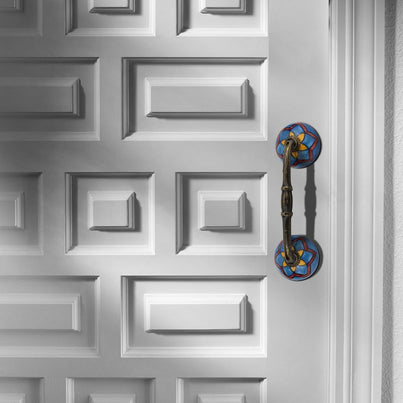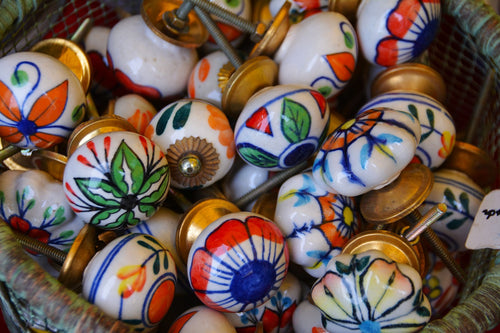
Mixing Knobs and Pulls on Kitchen Cabinets: A Trendy Approach to Kitchen Design
Cabinet hardware may seem like a subtle detail, but it plays a pivotal role in shaping the overall aesthetics of your kitchen. A rising trend, capturing the imagination of homeowners and designers alike, is the art of mixing knobs and pulls on kitchen cabinets. This innovative approach not only introduces visual interest but also provides an avenue for personalized and expressive kitchen design.
Table of Content
- The Evolution of Kitchen Design Trends
- Benefits of Mixing Knobs and Pulls
- Choosing the Right Combination
- Experimenting with Shapes
- The Practicality of Mixing Knobs and Pulls (Handles)
- Steps to Mixing Knobs and Pulls on Kitchen
- Conclusion
- FAQ
The Evolution of Kitchen Design Trends
Over time, the kitchen has evolved from a purely functional space to a focal point of the home. Traditional kitchen designs, with their emphasis on symmetry and uniformity, have given way to more contemporary styles that prioritize individual expression. The current trend reflects a desire for kitchens that go beyond mere functionality, becoming spaces that showcase the unique tastes and personalities of their inhabitants.

Benefits of Mixing Knobs and Pulls
When you choose to mix knobs and pulls, you're not just making a stylistic choice; you're unlocking a world of benefits. The visual interest that comes with combining different shapes and styles of hardware adds a layer of sophistication to your kitchen. Moreover, this approach provides an unparalleled opportunity for self-expression. Your kitchen becomes a canvas where you can showcase your personality and design sensibilities. The versatility of design options ensures that your kitchen is not confined to a one-size-fits-all approach but tailored to your unique preferences.
Choosing the Right Combination
Choosing the right combination of knobs and pulls is akin to curating a work of art. The starting point is establishing a cohesive foundation through consistent finishes. This doesn't mean all hardware has to be identical, but there should be a unifying element, be it color or finish. For instance, you might choose to have all pulls in brushed nickel and all knobs in matte black.
This creates a harmonious backdrop for the more intricate design choices to shine.
Complementary styles play a crucial role in ensuring that the different elements work together seamlessly. If your pulls have a sleek and modern design, consider pairing them with similarly styled knobs to maintain a sense of unity. At the same time, consider the functionality of each piece.
Pulls are often more ergonomic for larger, heavier drawers, while knobs might be more suitable for smaller cabinets. This thoughtful approach ensures that your design not only looks good but also serves its purpose effectively.

Experimenting with Shapes
One of the most exciting aspects of embracing the trend is the opportunity to experiment with shapes. Combine round knobs with elongated pulls, or vice versa, to infuse a dynamic element into your kitchen design.
Think of your kitchen as a canvas, and the hardware as the brushstrokes that bring it to life. The trend of mixing knobs and pulls allows you to be an artist, experimenting with shapes to create a visually stunning masterpiece.
Consider combining round knobs with long, horizontal pulls for a balanced and dynamic look. The interplay of curves and straight lines adds a layer of sophistication to your kitchen design, making it a conversation starter and a feast for the eyes.
The Practicality of Mixing Knobs and Pulls (Handles)
While the trend is undeniably stylish, it's crucial to address the practical aspects of mixing knobs and pulls.
Beauty should not come at the expense of functionality. When you decide to mix knobs and pulls, it's essential to consider the practical aspects of daily use.
Imagine the comfort of opening a drawer effortlessly, thanks to a well-placed pull, or the ease of grabbing a quick snack from a cabinet with a perfectly sized knob. Testing the ergonomics of your chosen hardware ensures that your kitchen not only looks good but also functions seamlessly in your daily life.
Durability is another crucial consideration.
The kitchen is a high-traffic area, and the hardware, being in constant use, should withstand the test of time. Opt for high-quality materials that not only enhance the aesthetic appeal but also ensure the longevity of your investment. This is especially important for areas prone to moisture or heavy usage, where durability becomes synonymous with a wise design choice.


Steps to Mixing Knobs and Pulls on Kitchen
Starting the mix of knobs and pulls can be both exciting and a bit challenging. A step-by-step guide is like a helpful roadmap, taking homeowners through each part of the process. Here's a breakdown of the key steps for mixing knobs and pulls in your kitchen design:
1. Assess Your Style Preferences:
Begin the process by identifying your design preferences. Determine whether you lean towards modern, sleek designs or if you prefer a more classic and timeless aesthetic. Understanding your style is crucial as it will influence the finishes, shapes, and styles you choose for the knobs and pulls in your kitchen.
2. Establish a Unified Finish:
When mixing knobs and pulls, cohesion is key. Choose a finish that ties all the elements together seamlessly. Whether it's the contemporary appeal of chrome, the timeless elegance of brass, or the trendy sophistication of matte black, a consistent finish creates a cohesive and intentional look. This ensures that the combination of different hardware appears purposeful rather than haphazard.
3. Consider Complementary Styles:
If you've chosen pulls with a specific style, make sure the knobs complement rather than compete with them. For instance, if your pulls feature intricate detailing, opt for simpler knobs to maintain a balanced overall look. The goal is to achieve harmony between the two types of hardware, creating a cohesive and visually pleasing kitchen design.
4. Test Ergonomics:
Beyond aesthetics, consider the functionality of each hardware piece. Pulls, with their elongated design, are generally more ergonomic for larger drawers. On the other hand, knobs may be more suitable for smaller cabinets. Test the feel of each in your hand to ensure comfort in daily use. Functionality is as crucial as style when it comes to selecting the right mix of knobs and pulls for your kitchen.
5. Mix Shapes for Visual Interest:
Experimenting with different shapes adds visual interest to your kitchen design. While maintaining a unified finish, play with various shapes for knobs and pulls. For example, consider pairing square knobs with long, sleek pulls. The mix of shapes can elevate the overall aesthetic, adding a layer of sophistication to your kitchen cabinets and drawers.
6. Balance the Distribution:
Achieving a balanced look involves thoughtful distribution of knobs and pulls. Ensure that there's a harmonious balance across your kitchen cabinets. You might choose to use pulls for larger cabinets and drawers while incorporating knobs for smaller ones. This balanced distribution enhances the overall visual appeal of your kitchen.
7. Seek Inspiration:
Explore design magazines, online platforms, and kitchen showrooms to seek inspiration for mixing knobs and pulls. Look for real-life examples where designers have successfully combined different hardware elements. This can provide valuable insights into what works well together and help you envision the potential for your kitchen.
8. Consider Durability:
Don't overlook the durability of the materials used for knobs and pulls. Kitchen hardware is subjected to frequent use, so choosing high-quality, durable materials ensures longevity and functionality. Consider factors such as resistance to corrosion, ease of cleaning, and overall durability when making your selections.

Conclusion
It's important to keep in mind that mixing knobs and pulls can also be a cost-effective way to update your kitchen without having to replace all of your cabinets. By simply swapping out the hardware, you can give your kitchen a fresh new look and feel. Additionally, mixing knobs and pulls can be a great way to add value to your home if you're planning on selling in the future. A well-designed kitchen with thoughtfully chosen hardware can be a major selling point for potential buyers. So, whether you're looking to update your kitchen for personal enjoyment or to increase the value of your home, mixing knobs and pulls is a trendy and practical approach to kitchen design.
Frequently Asked Questions (FAQs)
Q1: Why is mixing knobs and pulls considered a trendy approach to kitchen design?
Mixing knobs and pulls adds visual interest and allows for a personalized and expressive kitchen design. It's a rising trend that goes beyond functionality, showcasing individual tastes and preferences.
Q2: How do I choose the right combination of knobs and pulls for my kitchen cabinets?
Start by assessing your style preferences, establish a unified finish, consider complementary styles, test ergonomics, and experiment with shapes. Seek inspiration from design sources and prioritize durability in your selections.
Q3: What are the benefits of mixing knobs and pulls in kitchen design?
Mixing knobs and pulls introduces visual sophistication, offers a canvas for self-expression, and allows for versatile design options tailored to individual preferences.
Q4: Can mixing different shapes of knobs and pulls enhance the overall aesthetic of the kitchen?
Yes, experimenting with shapes adds visual interest. Combining different shapes, such as pairing square knobs with long, sleek pulls, elevates the aesthetic and creates a balanced and dynamic look.
Q5: How can I achieve a balanced look when mixing knobs and pulls in my kitchen?
Balance distribution by thoughtfully placing pulls on larger cabinets and drawers while incorporating knobs for smaller ones. This ensures a harmonious visual appeal across the entire kitchen.
Q6: Is mixing knobs and pulls a cost-effective way to update my kitchen?
Yes, it can be a cost-effective way to refresh your kitchen without replacing all cabinets. Swapping out hardware is a simple yet impactful update, providing a fresh look and feel.
Q7: What considerations should I keep in mind regarding the durability of knobs and pulls?
Choose high-quality, durable materials resistant to corrosion and easy to clean. Durability is crucial, especially in high-traffic areas like the kitchen, ensuring longevity and functionality.
Q8: Can mixing knobs and pulls add value to my home if I plan to sell in the future?
Yes, a well-designed kitchen with thoughtfully chosen hardware can be a major selling point. Mixing knobs and pulls is a trendy and practical approach that can enhance the overall appeal of your home.

